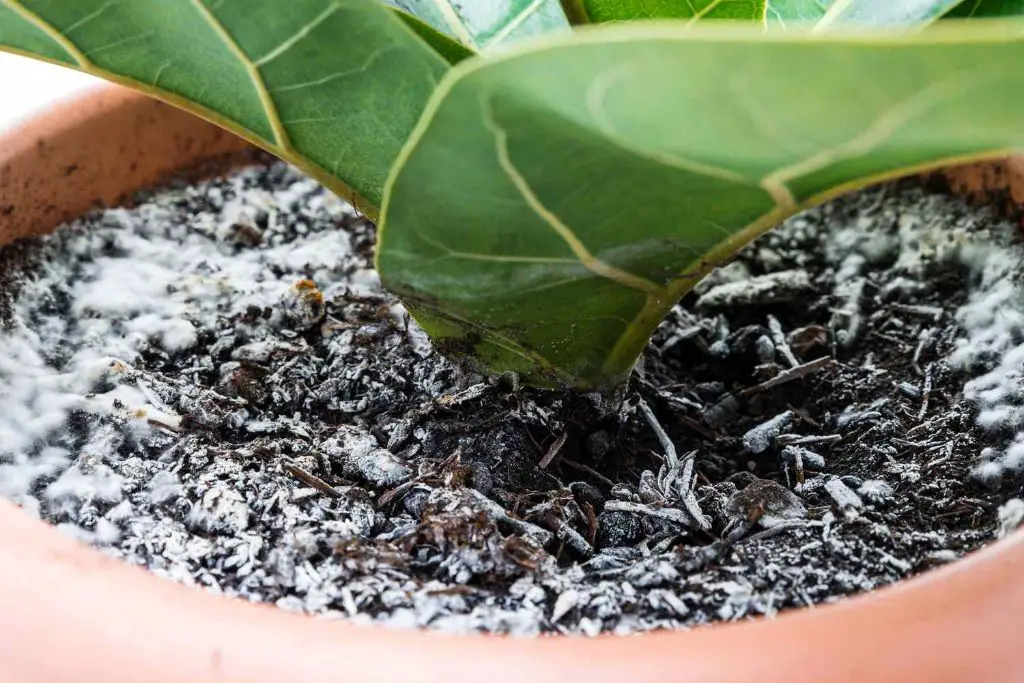Mold growth is a common issue that many houseplant owners face. While mold spores are present everywhere, they thrive in the damp, organic material of potting soil. When conditions are right, these spores germinate and spread, forming fuzzy mold colonies on the soil surface or plant roots. Though not inherently dangerous to plants, mold can harm delicate roots and indicate overwatering issues. Fortunately, mold in potting mix can be controlled and removed with a few simple fixes.
Page Contents
What Causes Mold in Houseplant Soil?
The main factors that promote mold growth in houseplant pots are:
- Moisture – Mold thrives in damp conditions. Overwatering allows moisture to linger in the soil.
- Poor drainage – Dense, compacted soil prevents excess water from draining properly.
- Lack of air circulation – Stagnant, still air surrounds plants kept in enclosed spaces or crowded conditions.
- Organic matter – Potting soils, composts, and other amendments provide nutrients for mold.
- Warm temperatures – Mold grows quickest between 70-90°F.
By recognizing what allows mold to flourish, steps can be taken to correct environmental conditions and prevent future outbreaks.
How to Get Rid of Mold in Potting Soil
If you spot mold in your houseplant’s soil, act quickly to get rid of it using these methods:
1. Remove Affected Soil
The most direct way to eliminate mold is by taking away its food source. Use a spoon or small trowel to scrape off the top 1-2 inches of potting mix which contains the mold colonies. Remove any soil that looks discolored or feels slimy. Take care not to damage plant roots in the process.
Discard the moldy soil in the trash. Do not compost it or reuse in other plants, as this risks spreading spores further.
2. Rinse Off Roots
After removing the affected potting mix, gently shake or rinse off the plant’s roots to clear away any remaining mold spores. Use room temperature water to avoid shocking the roots. Allow the roots to air dry before repotting.
3. Repot In Fresh Mix
Repot the plant in a clean container using fresh, sterile potting soil. Choose a soilless mix containing peat or coconut coir that drains well and resists compaction. When repotting, don’t pack the mix too tightly. Leave a little air space around the roots.
Disinfect the empty pot with a diluted bleach solution (1 part bleach to 9 parts water) before reuse. Rinse thoroughly.
4. Apply Fungicide Drench
Water newly repotted plants with a fungicide drench to kill off any remaining mold spores. Use a product containing neem oil, hydrogen peroxide, baking soda, or copper according to label directions. Fungicides are preventative and will not harm plants when used properly.
5. Adjust Watering Habits
Going forward, modify your watering practices to allow plants to dry out more between waterings. Always pour off any water that collects in saucers beneath pots after watering. Avoid getting foliage and stems wet when watering.
Check soil moisture before watering again. Only water when the top few inches become dry. Proper moisture control starves out mold spores so they cannot return.
How to Prevent Mold in Potting Soil
Once mold has been successfully removed, take steps to prevent future outbreaks by optimizing growing conditions:
- Use well-draining soil mixes – Avoid dense, moisture-retentive products.
- Water thoroughly but infrequently – Allow soil to partially dry out between waterings.
- Provide good air flow – Space plants out, use small fans.
- Control humidity – Dehumidify enclosed areas.
- Avoid overcrowding plants – Relieve congestion, repot when necessary.
- Clean up excess moisture – Pour off drained water, dry leaves.
- Sterilize reused pots – Disinfect with bleach solution before reuse.
- Use preventative fungicides – Apply as a soil drench every few weeks.
Catching mold issues early and making suitable corrections to soil, moisture, and air quality will go a long way towards keeping houseplants mold-free in the future.
Conclusion
Mold growth is a nuisance for indoor gardeners but doesn’t have to spell disaster for your houseplants. The keys are acting promptly when mold is spotted, eliminating affected soil, making cultural corrections, and using fungicides as needed to prevent recurrence. With some added diligence monitoring soil moisture and air circulation, you can get mold under control and keep your plants healthy and thriving.
